Factory Robot Market
Factory Robot Market Size and Share Forecast Outlook 2025 to 2035
Factory robot market is projected to grow from USD 18.0 billion in 2025 to USD 26.6 billion by 2035, at a CAGR of 4.0%. Articulated Robots will dominate with a 55.0% market share, while material handling & pick-and-place will lead the function segment with a 42.0% share.
Factory Robot Market Forecast and Outlook 2025 to 2035
The factory robot market trajectory from USD 18.0 billion in 2025 to USD 26.5 billion by 2035 represents steady expansion, the market will rise at a CAGR of 4.0% which demonstrating consistent adoption of industrial automation technologies and increasing investment in manufacturing applications across automotive manufacturers, electronics producers, and general manufacturing specialists worldwide.
Quick Stats for Factory Robot Market
- Factory Robot Market Value (2025): USD 18.0 billion
- Factory Robot Market Forecast Value (2035): USD 26.5 billion
- Factory Robot Market Forecast CAGR: 4.0%
- Leading Robot Class in Factory Robot Market: Articulated Robots
- Key Growth Regions in Factory Robot Market: North America, Europe, and Asia Pacific
- Key Players in Factory Robot Market: FANUC, ABB, Yaskawa, KUKA
- Where revenue comes from - Now Vs Next (Industry-level view)
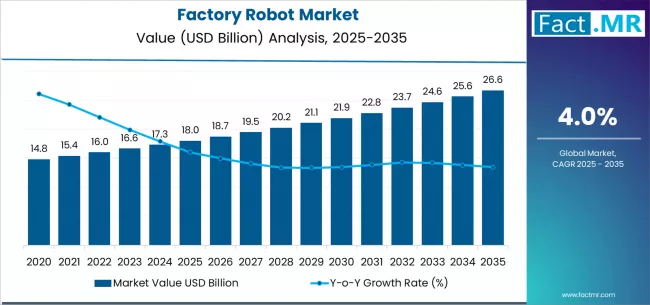
The market operates within a mature landscape characterized by established automation capabilities, industrial modernization initiatives, and growing demand for reliable robotic systems across articulated robots, SCARA, and delta/gantry applications. Market dynamics reflect increasing investment in manufacturing infrastructure, steady adoption of proven robotic technologies, and rising demand for versatile robotic solutions that support diverse production requirements and efficiency specifications across global manufacturing networks.
Procurement patterns demonstrate preferences toward articulated robot systems that combine operational flexibility, reliability performance, and manufacturing capabilities. Automotive manufacturers and electronics producers prioritize robot durability, production efficiency, and operational reliability when selecting robotic solutions for critical applications including material handling, welding operations, assembly processes, and specialized manufacturing procedures.
The market benefits from sustained industrial activities across automotive, electronics, and general manufacturing sectors, driving demand for proven robotic equipment that enables established production procedures. Growing focus on manufacturing efficiency and quality consistency creates opportunities for manufacturers offering certified robotic systems with comprehensive automation assurance and technical support capabilities.
Technology advancement influences market evolution through integration of collaborative systems, enhanced programming capabilities, and improved precision features that optimize manufacturing efficiency and production quality outcomes. Manufacturers focus on developing robotic solutions that accommodate varying payload requirements, application specifications, and automation parameters while maintaining consistent performance throughout extended operation periods.
The factory robot market demonstrates steady growth fundamentals driven by consistent manufacturing activities, industrial automation development, and increasing demand for reliable robotic equipment across multiple manufacturing sectors and geographic regions.
The first half of the decade (2025-2030) will witness market growth from USD 18.0 billion to approximately USD 21.8 billion, adding USD 3.8 billion in value, representing 45% of the total forecast period expansion. This phase will be characterized by steady adoption of proven robotic systems, driven by manufacturing modernization programs and consistent demand for reliable automation solutions across industrial applications.
The latter half (2030-2035) will experience continued growth from USD 21.8 billion to USD 26.5 billion, representing an addition of USD 4.7 billion or 55% of the decade expansion. This period will be defined by gradual market penetration of advanced manufacturing technologies, integration with production management systems, and enhanced connectivity with existing industrial infrastructure.
| Period | Primary Revenue Buckets | Share | Notes |
|---|---|---|---|
| Today | Articulated robots | 55% | Versatile applications, established technology |
| Material handling & pick-and-place | 42% | Automation efficiency, production optimization | |
| Fully automated lines | 48% | Complete automation, advanced manufacturing | |
| Future (3-5 yrs) | Advanced articulated systems | 56-59% | Enhanced capabilities, improved precision |
| Material handling applications | 43-46% | Automation expansion, efficiency focus | |
| Assembly applications | 29-33% | Precision manufacturing, quality control | |
| Welding & joining functions | 27-31% | Industrial processes, quality applications | |
| Delta/gantry systems | 26-30% | High-speed applications, specialized tasks | |
| Fully automated systems | 49-52% | Complete automation, advanced integration | |
| SCARA robots | 17-21% | Precision assembly, electronics manufacturing |
Factory Robot Market Key Takeaways
At-a-Glance Metrics
| Metric | Value |
|---|---|
| Market Value (2025) | USD 18.0 billion |
| Market Forecast (2035) | USD 26.5 billion |
| Growth Rate | 4.0% CAGR |
| Leading Robot Class | Articulated Robots |
| Primary Function | Material Handling & Pick-and-Place |
The market demonstrates stable fundamentals with articulated robots capturing dominant share through proven versatility and manufacturing optimization. Material handling and pick-and-place functions drive primary demand, supported by consistent manufacturing automation requirements and production efficiency modernization initiatives. Geographic distribution remains concentrated in developed manufacturing markets with established automation infrastructure, while emerging economies show steady adoption rates driven by industrial expansion programs and rising manufacturing investment.
Imperatives for Stakeholders in Factory Robot Market
Design for manufacturing reliability, not just functionality
- Offer complete robotic systems: factory robots + control software + integration services + maintenance support + training programs + production optimization.
- Preconfigured manufacturing workflows: production specifications, integration procedures, quality control, and facility management systems for industrial operations.
Production integration readiness
- Real-time performance monitoring, production tracking, and smart manufacturing integration (production management systems, industrial automation platforms).
Quality-by-design approach
- Advanced robotic systems, reliable automation control, manufacturing safety compatibility, and comprehensive production documentation.
Value-based pricing models
- Clear base robot price + transparent service tiers (integration services, maintenance support, performance guarantees); subscriptions for monitoring and optimization services.
Segmental Analysis
How do articulated robots, material handling applications, and fully automated lines drive leadership in the factory robot market?
Primary Classification: The market segments by robot class into articulated robots, SCARA, and delta/gantry systems, representing evolution from basic automation to comprehensive manufacturing solutions for industrial production optimization.
Secondary Classification: Function segmentation divides the market into material handling and pick-and-place, welding and joining, and assembly applications, reflecting distinct requirements for production processes, operational specifications, and manufacturing capabilities.
Tertiary Classification: Automation level segmentation covers fully automated lines, hybrid lines, and manual assist applications, while distribution channels span direct manufacturer sales, automation integrators, and specialized robotics suppliers.
Regional Classification: Geographic distribution covers North America, Europe, Asia Pacific, and other regions, with developed manufacturing markets leading adoption while emerging economies show steady growth patterns driven by industrial expansion and automation infrastructure development programs.
The segmentation structure reveals technology progression from traditional manufacturing automation toward comprehensive production systems with enhanced flexibility capabilities, while application diversity spans from automotive production to specialized electronics manufacturing requiring precise robotic specifications.
By Robot Class, the Articulated Robots Segment Accounts for Dominant Market Share
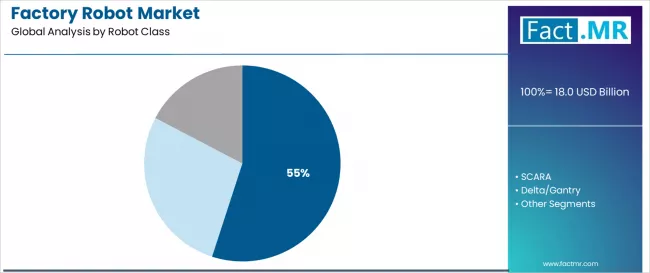
Market Position: Articulated robots command the leading position in the market with 55.0% market share through proven manufacturing technologies, including flexible robotic systems, reliable automation mechanisms, and production optimization that enable manufacturing operators to achieve optimal production conditions across diverse automotive and electronics manufacturing environments.
Value Drivers: The segment benefits from manufacturing operator preference for versatile robotic systems that provide consistent production performance, operational reliability, and application flexibility without requiring specialized programming requirements. Advanced articulated processing features enable enhanced production uniformity, reliable operational control, and integration with existing manufacturing management systems, where production effectiveness and operational efficiency represent critical manufacturing requirements.
Competitive Advantages: Articulated robots differentiate through proven manufacturing reliability, application compatibility, and integration with established production management systems that enhance industrial effectiveness while maintaining optimal production standards suitable for diverse manufacturing applications.
Key market characteristics:
- Advanced robotic designs with optimized production uniformity and operational reliability capabilities
- Enhanced manufacturing effectiveness, enabling 88-92% satisfaction with consistent production performance
- Industrial compatibility, including productivity optimization, operational efficiency, and performance monitoring for manufacturing operations
SCARA Systems Show Precision Market Position
SCARA systems maintain a 18.0% market position in the market due to their precision configuration advantages and assembly application benefits. These systems appeal to manufacturers requiring specialized robotic solutions with enhanced accuracy profiles for electronics manufacturing operations. Market growth is driven by precision manufacturing expansion, focusing specialized robotic solutions and quality excellence through optimized precision handling designs.
Delta/Gantry Systems Serve High-Speed Markets
Delta/gantry systems capture 27.0% market share through high-speed manufacturing requirements and specialized applications. These robots provide efficient solutions for rapid processing, packaging operations, and applications where traditional articulated robots limit high-speed deployment.
By Function, the Material Handling & Pick-and-Place Segment Shows Strong Growth
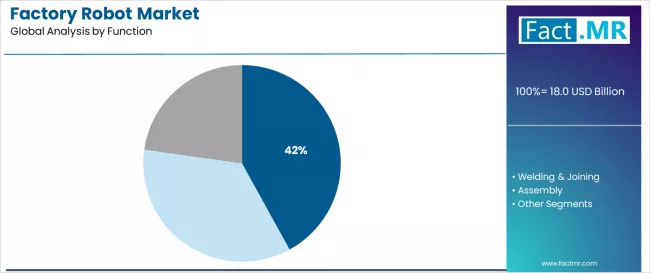
Market Context: Material handling and pick-and-place applications demonstrate strong market presence in the market with 42.0% market share due to widespread adoption of automation technologies and increasing focus on production efficiency, material movement, and manufacturing optimization that maximize operational effectiveness while maintaining quality integrity standards.
Appeal Factors: Manufacturing operators prioritize robot reliability, handling precision, and integration with existing production infrastructure that enables coordinated manufacturing procedures across multiple production protocols. The segment benefits from substantial manufacturing automation investment and production modernization programs that emphasize acquisition of efficient robotic systems for manufacturing optimization and industrial production applications.
Growth Drivers: Industrial expansion programs incorporate handling robots as essential components for production operations, while efficiency growth increases demand for reliable automation capabilities that comply with manufacturing standards and enhance production performance.
Market Challenges: Varying manufacturing protocols and integration complexity may limit robot standardization across different production facilities or operational scenarios.
Application dynamics include:
- Strong growth in manufacturing facilities and production networks requiring efficient robotic capabilities
- Increasing adoption in automation chains and handling applications for manufacturing operators
- Rising integration with production control systems for operational optimization and quality assurance
Welding & Joining Applications Maintain Industrial Demand
Welding and joining applications capture 28.0% market share through industrial processing requirements in manufacturing centers, production facilities, and processing applications. These facilities demand high-performance robotic systems capable of supporting welding protocols while providing process quality and operational reliability capabilities.
Assembly Applications Show Manufacturing Growth
Assembly applications account for 30.0% market share, including precision assembly, component integration, and manufacturing applications requiring reliable robotic capabilities for assembly-focused manufacturing operations and quality optimization.
By Automation Level, Fully Automated Lines Applications Drive Market Leadership
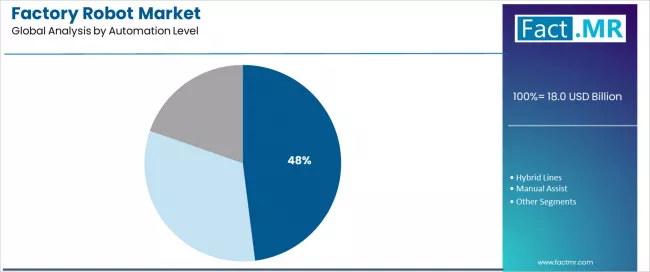
Market Context: Fully Automated Lines Applications dominate the market with 48.0% market share, reflecting the primary demand source for factory robot technology in complete automation and advanced manufacturing optimization.
Business Model Advantages: Fully Automated Lines Applications provide direct market demand for comprehensive automation systems, driving technology innovation and operational optimization while maintaining production control and efficiency consistency requirements.
Operational Benefits: Fully automated applications include production optimization, manufacturing efficiency, and operational excellence that drive consistent demand for robotic systems while providing access to latest automation technologies.
Hybrid Lines Applications Show Flexible Demand
Hybrid lines applications capture 34.0% market share through flexible automation requirements in mixed operations, collaborative facilities, and balanced applications. These applications demand performance-balanced robotic systems capable of supporting hybrid protocols while providing operational flexibility and human collaboration capabilities.
Manual Assist Applications Show Basic Automation Growth
Manual assist applications account for 18.0% market share, including operator support, basic automation, and assistance applications requiring reliable robotic capabilities for manual-focused manufacturing operations and operator assistance optimization.
What are the Drivers, Restraints, and Key Trends of the Factory Robot Market?
| Category | Factor | Impact | Why It Matters |
|---|---|---|---|
| Driver | Manufacturing automation & production efficiency (industrial modernization, quality requirements) | ★★★★★ | Growing automation demand requires reliable robotic systems with enhanced manufacturing capabilities and production properties proven effective across industrial applications. |
| Driver | Labor shortage & cost optimization (workforce challenges, operational efficiency) | ★★★★★ | Transforms manufacturing requirements from "manual operations" to "automated systems"; manufacturers that offer reliable robotic systems and efficiency features gain competitive advantage. |
| Driver | Quality consistency & precision manufacturing (automotive standards, electronics precision) | ★★★★☆ | Global manufacturing activities need consistent, reliable robots; demand for quality-controlled and precision-assured robotic solutions expanding addressable market. |
| Restraint | High capital investment & implementation costs (system costs, integration expenses) | ★★★★☆ | Smaller manufacturing operators defer robotic upgrades; increases cost sensitivity and slows advanced robot adoption in budget-conscious markets. |
| Restraint | Alternative automation solutions (fixed automation, manual processes, different technologies) | ★★★☆☆ | Alternative manufacturing methods offer established production processes and different cost structures, potentially limiting robot adoption in specific manufacturing applications. |
| Trend | Collaborative robotics & human-robot interaction (cobots, safety systems) | ★★★★★ | Collaborative automation properties, safety optimization, and interaction analytics transform manufacturing operations; collaboration integration and safety enhancement become core value propositions. |
| Trend | Digitalization & Industry 4.0 integration (connected systems, data analytics) | ★★★★☆ | Digital manufacturing solutions for connected production and specific applications; specialized connectivity capabilities drive competition toward integrated solutions. |
Analysis of the Factory Robot Market by Key Country
The market demonstrates varied regional dynamics with Growth Leaders including USA (5.0% growth rate) and Mexico (4.8% growth rate) driving expansion through manufacturing infrastructure development and automation modernization initiatives. Steady Performers encompass Germany (4.6% growth rate), France (4.3% growth rate), and developed regions, benefiting from established manufacturing networks and automation sector growth. Mature Markets feature South Korea (4.2% growth rate), Japan (3.9% growth rate), and UK (3.7% growth rate), where manufacturing advancement and automation optimization requirements support consistent growth patterns.
Regional synthesis reveals North American markets leading adoption through manufacturing expansion and automation development, while European countries maintain steady expansion supported by industrial regulations and manufacturing infrastructure investment. Asian markets show moderate growth driven by manufacturing applications and robotics technology integration trends.
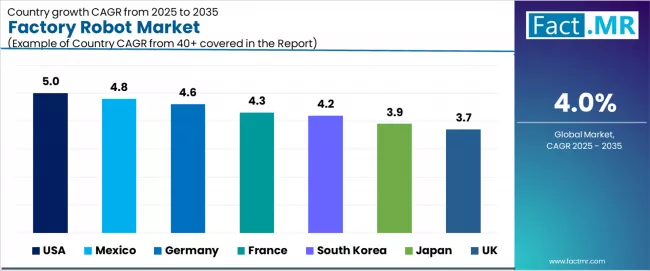
| Region/Country | 2025-2035 Growth | How to win | What to watch out |
|---|---|---|---|
| USA | 5.0% | Focus on automation solutions | Labor policy changes; trade policies |
| Germany | 4.6% | Lead with precision systems | Industry 4.0 standards; compliance costs |
| France | 4.3% | Provide manufacturing applications | Economic factors; market competition |
| UK | 3.7% | Offer industrial expertise | Brexit effects; economic impacts |
| Mexico | 4.8% | Push manufacturing solutions | Infrastructure limitations; skills development |
| South Korea | 4.2% | Focus on technology integration | Market constraints; competitive dynamics |
| Japan | 3.9% | Emphasize quality manufacturing | Market saturation; technology maturity |
How is the USA driving leadership in manufacturing automation?
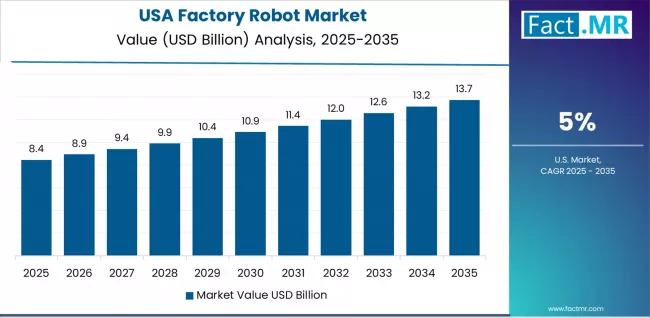
The USA establishes manufacturing automation leadership through comprehensive industrial development programs and advanced manufacturing infrastructure expansion, integrating factory robots as standard components in production networks and manufacturing operations. The country 5.0% growth rate reflects industry initiatives promoting manufacturing innovation capabilities and domestic production development that drives adoption of advanced robotic systems in automotive and electronics facilities. Growth concentrates in major manufacturing regions, where industrial development showcases integrated robotic systems that appeal to operators seeking automation precision capabilities and production management applications.
American manufacturers are developing advanced robotic solutions that combine domestic innovation advantages with manufacturing control features, including enhanced automation capabilities and improved production systems. Distribution channels through automation integrators and specialized suppliers expand market access, while industry support for manufacturing safety development supports adoption across diverse automotive and electronics segments.
Strategic Market Indicators:
- Government manufacturing programs providing substantial support for domestic robotics technology development
- Export market development for advanced robotic solutions targeting international manufacturing markets
How does Germany maintain excellence in manufacturing?
Germany advanced manufacturing market demonstrates sophisticated robot deployment with documented automation effectiveness in industrial applications and production facilities through integration with existing robotic systems and manufacturing infrastructure. The country leverages engineering expertise in robotics technologies and precision systems integration to maintain a 4.6% growth rate. Manufacturing facilities showcase premium installations where robotic systems integrate with comprehensive production platforms and industrial management systems to optimize manufacturing effectiveness and quality outcomes.
German manufacturers prioritize system quality and EU compliance in robot development, creating demand for premium systems with advanced features, including manufacturing integration and performance monitoring systems. The market benefits from established manufacturing infrastructure and willingness to invest in advanced robotic technologies that provide long-term operational benefits and compliance with international manufacturing standards.
Market Intelligence Brief:
- Engineering focuses on EU standardization and manufacturing compliance, driving premium segment growth
- Technology collaboration between German manufacturers and international manufacturing companies
- Professional training programs expanding robotic system integration in manufacturing scenarios
How is France demonstrating leadership in manufacturing innovation?
France market expansion benefits from diverse manufacturing demand, including industrial development in manufacturing regions, facility upgrades, and government manufacturing programs that increasingly incorporate advanced robotic solutions for industrial applications. The country maintains a 4.3% growth rate, driven by rising manufacturing activity and increasing recognition of advanced robotic benefits, including enhanced production management and manufacturing effectiveness.
Market dynamics focus on sophisticated robotic solutions that balance manufacturing performance with cost considerations important to French manufacturing operators. Growing industrial modernization creates continued demand for advanced robotic systems in new manufacturing infrastructure and production facility modernization projects.
Strategic Market Considerations:
- Manufacturing and industrial segments leading growth with focus on production control and efficiency applications
- Regional manufacturing requirements driving diverse product portfolio from standard systems to premium solutions
- Technology integration challenges balanced by strong manufacturing effectiveness and efficiency capabilities
How is the United Kingdom showcasing its expertise in industrial manufacturing?
The United Kingdom manufacturing market demonstrates integrated robot deployment with documented manufacturing effectiveness in industrial applications and production facilities through integration with existing robotic systems and manufacturing infrastructure. The country maintains a 3.7% growth rate, supported by industrial manufacturing programs and production efficiency requirements that promote advanced robotic systems for manufacturing applications. Manufacturing facilities across regions showcase systematic installations where robotic systems integrate with comprehensive production platforms to optimize manufacturing control and efficiency outcomes.
The UK manufacturing providers prioritize system reliability and industrial compatibility in robot procurement, creating demand for validated systems with proven manufacturing features, including performance monitoring integration and production management systems. The market benefits from established manufacturing infrastructure and efficiency requirements that support robotic technology adoption and manufacturing effectiveness.
Market Intelligence Brief:
- Industrial compatibility requirements driving standardized robotic system adoption
- Manufacturing partnerships providing automation validation and effectiveness data
- Technology integration between UK manufacturing providers and international robotics companies
Mexico Emerges as Manufacturing Growth Market
Mexico market growth benefits from expanding manufacturing development, including industrial modernization in manufacturing centers, facility upgrades, and government manufacturing programs that increasingly incorporate robotic solutions for industrial applications. The country maintains a 4.8% growth rate, driven by rising manufacturing activity and increasing recognition of robotic benefits, including enhanced manufacturing and production effectiveness.
Market dynamics focus on manufacturing-focused robotic solutions that meet international production standards and operational effectiveness requirements important to Mexican manufacturing operators. Growing manufacturing development creates continued demand for advanced robotic systems in new industrial infrastructure and manufacturing facility modernization projects.
Strategic Market Considerations:
- Manufacturing modernization and industrial segments leading growth with focus on production and automation applications
- Regional manufacturing requirements driving product adoption from standard systems to integrated solutions
- Infrastructure development challenges balanced by strong manufacturing growth and modernization capabilities
How is Japan driving advancements in quality manufacturing technology?
Japan market growth benefits from precision manufacturing demand, including advanced industrial facilities in manufacturing regions, quality integration, and production enhancement programs that increasingly incorporate robotic solutions for manufacturing applications. The country maintains a 3.9% growth rate, driven by manufacturing technology advancement and increasing recognition of precision robotic benefits, including accurate production management and enhanced manufacturing outcomes.
Market dynamics focus on high-precision robotic solutions that meet Japanese quality standards and manufacturing effectiveness requirements important to production operators. Advanced manufacturing technology adoption creates continued demand for sophisticated robotic systems in industrial facility infrastructure and manufacturing modernization projects.
Strategic Market Considerations:
- Manufacturing and precision segments leading growth with focus on advanced robotic systems and quality applications
- Quality requirements driving premium product adoption from sophisticated robotic systems
- Technology integration challenges balanced by strong manufacturing effectiveness and precision capabilities
- Manufacturing quality initiatives beginning to influence procurement standards and robotic requirements
How is South Korea establishing excellence in technology integration?
South Korea establishes stable market presence through comprehensive technology programs and manufacturing infrastructure development, integrating robotic systems across manufacturing and industrial applications. The country 4.2% growth rate reflects technology industry development and manufacturing adoption that supports use of robotic systems in production facilities and industrial operations. Growth concentrates in major manufacturing regions, where production technology showcases deployment that appeals to operators seeking proven robotic capabilities and manufacturing management applications.
Korean manufacturers leverage established technology relationships and technical support capabilities, including manufacturing design programs and training support that create customer relationships and operational advantages. The market benefits from technology standards and manufacturing safety requirements that support robotic system use while advancing technology development and manufacturing optimization.
Strategic Market Indicators:
- Established technology standards providing consistent demand for robotics technology advancement
- Technology integration programs expanding robotic capabilities in manufacturing scenarios
Europe Market Split by Country
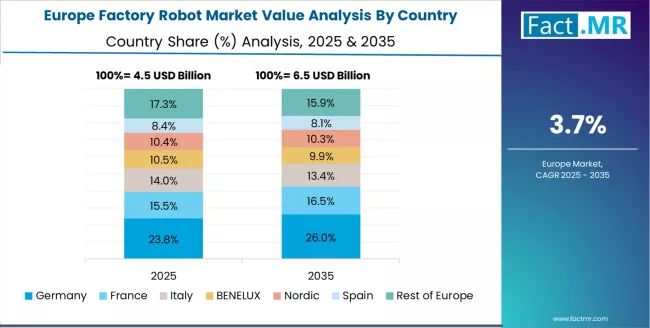
The factory robot market in Europe is projected to grow steadily over the forecast period, with Germany expected to maintain its leadership position with approximately 32.1% market share in 2025, declining slightly to 31.7% by 2035, supported by its advanced manufacturing infrastructure and major industrial hubs. The United Kingdom follows with a 21.8% share in 2025, projected to reach 21.4% by 2035, driven by comprehensive manufacturing operations and industrial programs. France holds a 22.4% share in 2025, expected to increase to 22.8% by 2035 through specialized manufacturing applications and industrial compliance requirements. Italy commands a 13.9% share, while Spain accounts for 7.2% in 2025. The rest of Europe region is anticipated to gain momentum, expanding its collective share from 2.6% to 2.9% by 2035, attributed to increasing robotic adoption in Nordic manufacturing countries and emerging Eastern European industrial facilities implementing manufacturing modernization programs.
How do advanced quality standards define the dynamics of the Japanese manufacturing market?
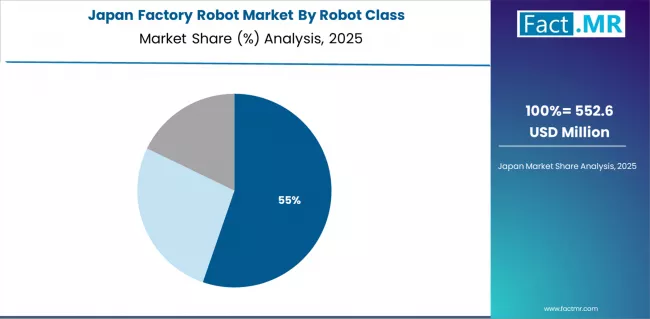
Japanese factory robot operations reflect the country's exacting quality standards and sophisticated manufacturing expectations. Major robotics manufacturers maintain rigorous supplier qualification processes that often exceed international standards, requiring extensive documentation, performance testing, and facility audits that can take 12-18 months to complete. This creates high barriers for new suppliers but ensures consistent quality that supports premium robotic positioning.
The Japanese market demonstrates unique robot class preferences with Articulated Robots accounting for 65.0%, Delta/Gantry 20.0%, and SCARA 15.0%. Companies require specific precision specifications and manufacturing requirements that differ from Western applications, driving demand for customized robotic capabilities.
Japanese market demonstrates unique function preferences with Material Handling & Pick-and-Place accounting for 50.0%, Assembly 30.0%, and Welding & Joining 20.0%. Companies require specific production control and manufacturing specifications that differ from Western applications, driving demand for customized manufacturing technologies.
Regulatory oversight emphasizes comprehensive manufacturing safety management and production requirements that surpass most international standards. The manufacturing registration system requires detailed safety information, creating advantages for suppliers with transparent safety chains and comprehensive manufacturing documentation systems.
Supply chain management focuses on relationship-based partnerships rather than purely transactional procurement. Japanese companies typically maintain long-term supplier relationships spanning decades, with annual contract negotiations focusing quality consistency over price competition. This stability supports investment in specialized manufacturing equipment tailored to Japanese robotic specifications.
How does manufacturing excellence drive the dynamics of the robotics market in South Korea?
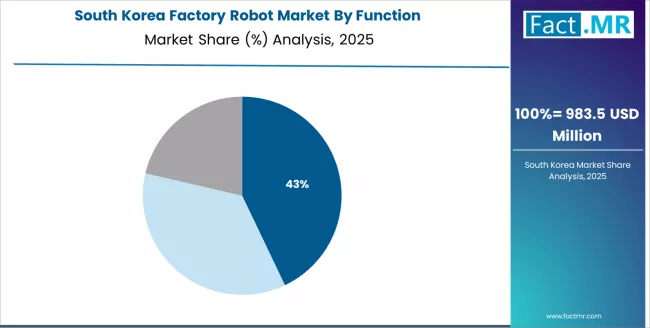
South Korean factory robot operations reflect the country's advanced manufacturing sector and technology-oriented business model. Major manufacturing companies drive sophisticated procurement strategies, establishing direct relationships with global suppliers to secure consistent quality and pricing for their industrial and production robotic operations targeting both domestic and international markets.
The Korean market demonstrates particular strength in automation level distribution with Fully Automated Lines accounting for 55.0%, Hybrid Lines 30.0%, Manual Assist 15.0%. This manufacturing-focused approach creates demand for specific automation specifications that differ from Western applications, requiring suppliers to adapt robotic processing and manufacturing techniques.
Regulatory frameworks emphasize manufacturing safety and production standards, with Korean manufacturing administration standards often exceeding international requirements. This creates barriers for smaller robotics suppliers but benefits established manufacturers who can demonstrate technology capabilities. The regulatory environment particularly favors suppliers with comprehensive certification and manufacturing documentation systems.
Supply chain efficiency remains critical given Korea's manufacturing focus and technology dependence. Companies increasingly pursue long-term contracts with suppliers in United States, Germany, and Japan to ensure reliable access to advanced robotic components while managing technology development risks. Technical manufacturing investments support quality advancement during competitive market periods.
The market faces pressure from technology advancement pace and competition from international manufacturers, driving manufacturing investments and technology development among domestic producers. The premium positioning of Korean manufacturing brands internationally continues to support demand for high-quality robotic systems that meet stringent manufacturing specifications.
What is the competitive landscape of the factory robot market?

Structure: Approximately 15-25 credible players; top 4-6 hold 62-67% by revenue.
Leadership is maintained through: technology innovation, manufacturing expertise, and product development (robotic reliability + manufacturing integration + production optimization).
What is commoditizing: basic robotic functions and standard automation systems.
Margin Opportunities: system integration services, manufacturing optimization, and incorporation into production workflows (efficiency analytics, predictive maintenance).
| Stakeholder | What they actually control | Typical strengths | Typical blind spots |
|---|---|---|---|
| Technology leaders | R&D capabilities, innovation expertise, advanced robotics | Superior technology; proven reliability; innovation leadership | Market accessibility; cost pressures |
| Manufacturing integrators | System integration, production expertise, implementation services | Complete solutions; proven integration; operational support | Technology dependence; product development |
| Global manufacturers | Production capacity, global presence, broad portfolios | Wide availability, manufacturing scale, multi-region support | Innovation pace; specialization focus |
| Regional specialists | Local support, responsive service, market knowledge | Close customer relationships; flexible service | Technology gaps; scaling limitations |
| Automation platforms | Manufacturing expertise, domain knowledge, industry relationships | Deep manufacturing knowledge; specialized solutions; customer intimacy | Technology evolution; competitive pressures |
The competitive landscape features established players leveraging comprehensive manufacturing industry relationships and proven robotic technologies. Technology leaders maintain leadership through superior R&D capabilities, proven reliability, and innovation expertise that create competitive advantages and market differentiation. Manufacturing integrators focus on system integration and production applications, offering complete solutions with proven manufacturing expertise.
Global manufacturers provide market presence, production capacity, and manufacturing scale with multi-region support capabilities that create customer loyalty and operational advantages. Regional specialists offer local market access through responsive service and support flexibility, delivering focused approach through customer relationship strategies. Automation platforms provide manufacturing expertise and domain knowledge, offering specialized solutions through deep industry relationships.
Market dynamics reflect steady technology advancement and manufacturing integration while established players expand through strategic partnerships and industrial market development. Competition centers around manufacturing reliability, system integration, and comprehensive production solutions that provide complete industrial support systems. Leading companies invest in collaborative robotics programs focusing on safety enhancement, manufacturing optimization, and market accessibility that differentiate their offerings in mature manufacturing markets.
Key Players in the Factory Robot Market
- FANUC
- ABB
- Yaskawa
- KUKA
- Kawasaki
- Denso
- Epson
- Staubli
- Universal Robots
- Mitsubishi Electric
- Comau
Scope of the Report
| Item | Value |
|---|---|
| Quantitative Units | USD 18.0 billion |
| Robot Class | Articulated Robots, SCARA, Delta/Gantry |
| Function | Material Handling & Pick-and-Place, Welding & Joining, Assembly |
| Automation Level | Fully Automated Lines, Hybrid Lines, Manual Assist |
| Regions Covered | North America, Europe, Asia Pacific, Latin America, Middle East & Africa |
| Countries Covered | USA, Germany, France, UK, Japan, South Korea, Mexico, Canada, Italy, Australia, and 20+ additional countries |
| Key Companies Profiled | FANUC, ABB, Yaskawa, KUKA, Kawasaki, Denso, Epson, Staubli |
| Additional Attributes | Dollar sales by robot class and function categories, regional adoption trends across North America, Europe, and Asia Pacific, competitive landscape with robotics manufacturers and automation integrators, manufacturing operator preferences for reliability and production effectiveness, integration with manufacturing execution platforms and industrial systems, innovations in robotics technology and automation enhancement, and development of advanced robotic solutions with enhanced manufacturing and production optimization capabilities. |
Factory Robot Market by Segments
-
Robot Class :
- Articulated Robots
- SCARA
- Delta/Gantry
-
Function :
- Material Handling & Pick-and-Place
- Welding & Joining
- Assembly
-
Automation Level :
- Fully Automated Lines
- Hybrid Lines
- Manual Assist
-
Region :
- North America
- United States
- Canada
- Mexico
- Europe
- Germany
- United Kingdom
- France
- Italy
- Spain
- Rest of Europe
- Asia Pacific
- Japan
- South Korea
- China
- India
- Australia & New Zealand
- Rest of Asia Pacific
- Latin America
- Brazil
- Rest of Latin America
- Middle East & Africa
- GCC Countries
- South Africa
- Rest of Middle East & Africa
- North America
Table of Content
- Executive Summary
- Global Market Outlook
- Demand to side Trends
- Supply to side Trends
- Technology Roadmap Analysis
- Analysis and Recommendations
- Market Overview
- Market Coverage / Taxonomy
- Market Definition / Scope / Limitations
- Market Background
- Market Dynamics
- Drivers
- Restraints
- Opportunity
- Trends
- Scenario Forecast
- Demand in Optimistic Scenario
- Demand in Likely Scenario
- Demand in Conservative Scenario
- Opportunity Map Analysis
- Product Life Cycle Analysis
- Supply Chain Analysis
- Investment Feasibility Matrix
- Value Chain Analysis
- PESTLE and Porter’s Analysis
- Regulatory Landscape
- Regional Parent Market Outlook
- Production and Consumption Statistics
- Import and Export Statistics
- Market Dynamics
- Global Market Analysis 2020 to 2024 and Forecast, 2025 to 2035
- Historical Market Size Value (USD Million) Analysis, 2020 to 2024
- Current and Future Market Size Value (USD Million) Projections, 2025 to 2035
- Y to o to Y Growth Trend Analysis
- Absolute $ Opportunity Analysis
- Global Market Pricing Analysis 2020 to 2024 and Forecast 2025 to 2035
- Global Market Analysis 2020 to 2024 and Forecast 2025 to 2035, By Robot Class
- Introduction / Key Findings
- Historical Market Size Value (USD Million) Analysis By Robot Class, 2020 to 2024
- Current and Future Market Size Value (USD Million) Analysis and Forecast By Robot Class, 2025 to 2035
- Articulated Robots
- SCARA
- Delta/Gantry
- Y to o to Y Growth Trend Analysis By Robot Class, 2020 to 2024
- Absolute $ Opportunity Analysis By Robot Class, 2025 to 2035
- Global Market Analysis 2020 to 2024 and Forecast 2025 to 2035, By Function
- Introduction / Key Findings
- Historical Market Size Value (USD Million) Analysis By Function, 2020 to 2024
- Current and Future Market Size Value (USD Million) Analysis and Forecast By Function, 2025 to 2035
- Material Handling & Pick-and-Place
- Welding & Joining
- Assembly
- Y to o to Y Growth Trend Analysis By Function, 2020 to 2024
- Absolute $ Opportunity Analysis By Function, 2025 to 2035
- Global Market Analysis 2020 to 2024 and Forecast 2025 to 2035, By Automation Level
- Introduction / Key Findings
- Historical Market Size Value (USD Million) Analysis By Automation Level, 2020 to 2024
- Current and Future Market Size Value (USD Million) Analysis and Forecast By Automation Level, 2025 to 2035
- Fully Automated Lines
- Hybrid Lines
- Manual Assist
- Y to o to Y Growth Trend Analysis By Automation Level, 2020 to 2024
- Absolute $ Opportunity Analysis By Automation Level, 2025 to 2035
- Global Market Analysis 2020 to 2024 and Forecast 2025 to 2035, By Region
- Introduction
- Historical Market Size Value (USD Million) Analysis By Region, 2020 to 2024
- Current Market Size Value (USD Million) Analysis and Forecast By Region, 2025 to 2035
- North America
- Latin America
- Western Europe
- Eastern Europe
- East Asia
- South Asia and Pacific
- Middle East & Africa
- Market Attractiveness Analysis By Region
- North America Market Analysis 2020 to 2024 and Forecast 2025 to 2035, By Country
- Historical Market Size Value (USD Million) Trend Analysis By Market Taxonomy, 2020 to 2024
- Market Size Value (USD Million) Forecast By Market Taxonomy, 2025 to 2035
- By Country
- USA
- Canada
- Mexico
- By Robot Class
- By Function
- By Automation Level
- By Country
- Market Attractiveness Analysis
- By Country
- By Robot Class
- By Function
- By Automation Level
- Key Takeaways
- Latin America Market Analysis 2020 to 2024 and Forecast 2025 to 2035, By Country
- Historical Market Size Value (USD Million) Trend Analysis By Market Taxonomy, 2020 to 2024
- Market Size Value (USD Million) Forecast By Market Taxonomy, 2025 to 2035
- By Country
- Brazil
- Chile
- Rest of Latin America
- By Robot Class
- By Function
- By Automation Level
- By Country
- Market Attractiveness Analysis
- By Country
- By Robot Class
- By Function
- By Automation Level
- Key Takeaways
- Western Europe Market Analysis 2020 to 2024 and Forecast 2025 to 2035, By Country
- Historical Market Size Value (USD Million) Trend Analysis By Market Taxonomy, 2020 to 2024
- Market Size Value (USD Million) Forecast By Market Taxonomy, 2025 to 2035
- By Country
- Germany
- UK
- Italy
- Spain
- France
- Nordic
- BENELUX
- Rest of Western Europe
- By Robot Class
- By Function
- By Automation Level
- By Country
- Market Attractiveness Analysis
- By Country
- By Robot Class
- By Function
- By Automation Level
- Key Takeaways
- Eastern Europe Market Analysis 2020 to 2024 and Forecast 2025 to 2035, By Country
- Historical Market Size Value (USD Million) Trend Analysis By Market Taxonomy, 2020 to 2024
- Market Size Value (USD Million) Forecast By Market Taxonomy, 2025 to 2035
- By Country
- Russia
- Poland
- Hungary
- Balkan & Baltic
- Rest of Eastern Europe
- By Robot Class
- By Function
- By Automation Level
- By Country
- Market Attractiveness Analysis
- By Country
- By Robot Class
- By Function
- By Automation Level
- Key Takeaways
- East Asia Market Analysis 2020 to 2024 and Forecast 2025 to 2035, By Country
- Historical Market Size Value (USD Million) Trend Analysis By Market Taxonomy, 2020 to 2024
- Market Size Value (USD Million) Forecast By Market Taxonomy, 2025 to 2035
- By Country
- China
- Japan
- South Korea
- By Robot Class
- By Function
- By Automation Level
- By Country
- Market Attractiveness Analysis
- By Country
- By Robot Class
- By Function
- By Automation Level
- Key Takeaways
- South Asia and Pacific Market Analysis 2020 to 2024 and Forecast 2025 to 2035, By Country
- Historical Market Size Value (USD Million) Trend Analysis By Market Taxonomy, 2020 to 2024
- Market Size Value (USD Million) Forecast By Market Taxonomy, 2025 to 2035
- By Country
- India
- ASEAN
- Australia & New Zealand
- Rest of South Asia and Pacific
- By Robot Class
- By Function
- By Automation Level
- By Country
- Market Attractiveness Analysis
- By Country
- By Robot Class
- By Function
- By Automation Level
- Key Takeaways
- Middle East & Africa Market Analysis 2020 to 2024 and Forecast 2025 to 2035, By Country
- Historical Market Size Value (USD Million) Trend Analysis By Market Taxonomy, 2020 to 2024
- Market Size Value (USD Million) Forecast By Market Taxonomy, 2025 to 2035
- By Country
- Kingdom of Saudi Arabia
- Other GCC Countries
- Turkiye
- South Africa
- Other African Union
- Rest of Middle East & Africa
- By Robot Class
- By Function
- By Automation Level
- By Country
- Market Attractiveness Analysis
- By Country
- By Robot Class
- By Function
- By Automation Level
- Key Takeaways
- Key Countries Market Analysis
- USA
- Pricing Analysis
- Market Share Analysis, 2024
- By Robot Class
- By Function
- By Automation Level
- Canada
- Pricing Analysis
- Market Share Analysis, 2024
- By Robot Class
- By Function
- By Automation Level
- Mexico
- Pricing Analysis
- Market Share Analysis, 2024
- By Robot Class
- By Function
- By Automation Level
- Brazil
- Pricing Analysis
- Market Share Analysis, 2024
- By Robot Class
- By Function
- By Automation Level
- Chile
- Pricing Analysis
- Market Share Analysis, 2024
- By Robot Class
- By Function
- By Automation Level
- Germany
- Pricing Analysis
- Market Share Analysis, 2024
- By Robot Class
- By Function
- By Automation Level
- UK
- Pricing Analysis
- Market Share Analysis, 2024
- By Robot Class
- By Function
- By Automation Level
- Italy
- Pricing Analysis
- Market Share Analysis, 2024
- By Robot Class
- By Function
- By Automation Level
- Spain
- Pricing Analysis
- Market Share Analysis, 2024
- By Robot Class
- By Function
- By Automation Level
- France
- Pricing Analysis
- Market Share Analysis, 2024
- By Robot Class
- By Function
- By Automation Level
- India
- Pricing Analysis
- Market Share Analysis, 2024
- By Robot Class
- By Function
- By Automation Level
- ASEAN
- Pricing Analysis
- Market Share Analysis, 2024
- By Robot Class
- By Function
- By Automation Level
- Australia & New Zealand
- Pricing Analysis
- Market Share Analysis, 2024
- By Robot Class
- By Function
- By Automation Level
- China
- Pricing Analysis
- Market Share Analysis, 2024
- By Robot Class
- By Function
- By Automation Level
- Japan
- Pricing Analysis
- Market Share Analysis, 2024
- By Robot Class
- By Function
- By Automation Level
- South Korea
- Pricing Analysis
- Market Share Analysis, 2024
- By Robot Class
- By Function
- By Automation Level
- Russia
- Pricing Analysis
- Market Share Analysis, 2024
- By Robot Class
- By Function
- By Automation Level
- Poland
- Pricing Analysis
- Market Share Analysis, 2024
- By Robot Class
- By Function
- By Automation Level
- Hungary
- Pricing Analysis
- Market Share Analysis, 2024
- By Robot Class
- By Function
- By Automation Level
- Kingdom of Saudi Arabia
- Pricing Analysis
- Market Share Analysis, 2024
- By Robot Class
- By Function
- By Automation Level
- Turkiye
- Pricing Analysis
- Market Share Analysis, 2024
- By Robot Class
- By Function
- By Automation Level
- South Africa
- Pricing Analysis
- Market Share Analysis, 2024
- By Robot Class
- By Function
- By Automation Level
- USA
- Market Structure Analysis
- Competition Dashboard
- Competition Benchmarking
- Market Share Analysis of Top Players
- By Regional
- By Robot Class
- By Function
- By Automation Level
- Competition Analysis
- Competition Deep Dive
- FANUC
- Overview
- Product Portfolio
- Profitability by Market Segments (Product/Age /Sales Channel/Region)
- Sales Footprint
- Strategy Overview
- Marketing Strategy
- Product Strategy
- Channel Strategy
- ABB
- Yaskawa
- KUKA
- Kawasaki
- Denso
- Epson
- Staubli
- Universal Robots
- Mitsubishi Electric
- Comau
- FANUC
- Competition Deep Dive
- Assumptions & Acronyms Used
- Research Methodology
List Of Table
- Table 1: Global Market Value (USD Million) Forecast by Region, 2020 to 2035
- Table 2: Global Market Value (USD Million) Forecast by Robot Class, 2020 to 2035
- Table 3: Global Market Value (USD Million) Forecast by Function, 2020 to 2035
- Table 4: Global Market Value (USD Million) Forecast by Automation Level, 2020 to 2035
- Table 5: North America Market Value (USD Million) Forecast by Country, 2020 to 2035
- Table 6: North America Market Value (USD Million) Forecast by Robot Class, 2020 to 2035
- Table 7: North America Market Value (USD Million) Forecast by Function, 2020 to 2035
- Table 8: North America Market Value (USD Million) Forecast by Automation Level, 2020 to 2035
- Table 9: Latin America Market Value (USD Million) Forecast by Country, 2020 to 2035
- Table 10: Latin America Market Value (USD Million) Forecast by Robot Class, 2020 to 2035
- Table 11: Latin America Market Value (USD Million) Forecast by Function, 2020 to 2035
- Table 12: Latin America Market Value (USD Million) Forecast by Automation Level, 2020 to 2035
- Table 13: Western Europe Market Value (USD Million) Forecast by Country, 2020 to 2035
- Table 14: Western Europe Market Value (USD Million) Forecast by Robot Class, 2020 to 2035
- Table 15: Western Europe Market Value (USD Million) Forecast by Function, 2020 to 2035
- Table 16: Western Europe Market Value (USD Million) Forecast by Automation Level, 2020 to 2035
- Table 17: Eastern Europe Market Value (USD Million) Forecast by Country, 2020 to 2035
- Table 18: Eastern Europe Market Value (USD Million) Forecast by Robot Class, 2020 to 2035
- Table 19: Eastern Europe Market Value (USD Million) Forecast by Function, 2020 to 2035
- Table 20: Eastern Europe Market Value (USD Million) Forecast by Automation Level, 2020 to 2035
- Table 21: East Asia Market Value (USD Million) Forecast by Country, 2020 to 2035
- Table 22: East Asia Market Value (USD Million) Forecast by Robot Class, 2020 to 2035
- Table 23: East Asia Market Value (USD Million) Forecast by Function, 2020 to 2035
- Table 24: East Asia Market Value (USD Million) Forecast by Automation Level, 2020 to 2035
- Table 25: South Asia and Pacific Market Value (USD Million) Forecast by Country, 2020 to 2035
- Table 26: South Asia and Pacific Market Value (USD Million) Forecast by Robot Class, 2020 to 2035
- Table 27: South Asia and Pacific Market Value (USD Million) Forecast by Function, 2020 to 2035
- Table 28: South Asia and Pacific Market Value (USD Million) Forecast by Automation Level, 2020 to 2035
- Table 29: Middle East & Africa Market Value (USD Million) Forecast by Country, 2020 to 2035
- Table 30: Middle East & Africa Market Value (USD Million) Forecast by Robot Class, 2020 to 2035
- Table 31: Middle East & Africa Market Value (USD Million) Forecast by Function, 2020 to 2035
- Table 32: Middle East & Africa Market Value (USD Million) Forecast by Automation Level, 2020 to 2035
List Of Figures
- Figure 1: Global Market Pricing Analysis
- Figure 2: Global Market Value (USD Million) Forecast 2020-2035
- Figure 3: Global Market Value Share and BPS Analysis by Robot Class, 2025 and 2035
- Figure 4: Global Market Y to o to Y Growth Comparison by Robot Class, 2025-2035
- Figure 5: Global Market Attractiveness Analysis by Robot Class
- Figure 6: Global Market Value Share and BPS Analysis by Function, 2025 and 2035
- Figure 7: Global Market Y to o to Y Growth Comparison by Function, 2025-2035
- Figure 8: Global Market Attractiveness Analysis by Function
- Figure 9: Global Market Value Share and BPS Analysis by Automation Level, 2025 and 2035
- Figure 10: Global Market Y to o to Y Growth Comparison by Automation Level, 2025-2035
- Figure 11: Global Market Attractiveness Analysis by Automation Level
- Figure 12: Global Market Value (USD Million) Share and BPS Analysis by Region, 2025 and 2035
- Figure 13: Global Market Y to o to Y Growth Comparison by Region, 2025-2035
- Figure 14: Global Market Attractiveness Analysis by Region
- Figure 15: North America Market Incremental Dollar Opportunity, 2025-2035
- Figure 16: Latin America Market Incremental Dollar Opportunity, 2025-2035
- Figure 17: Western Europe Market Incremental Dollar Opportunity, 2025-2035
- Figure 18: Eastern Europe Market Incremental Dollar Opportunity, 2025-2035
- Figure 19: East Asia Market Incremental Dollar Opportunity, 2025-2035
- Figure 20: South Asia and Pacific Market Incremental Dollar Opportunity, 2025-2035
- Figure 21: Middle East & Africa Market Incremental Dollar Opportunity, 2025-2035
- Figure 22: North America Market Value Share and BPS Analysis by Country, 2025 and 2035
- Figure 23: North America Market Value Share and BPS Analysis by Robot Class, 2025 and 2035
- Figure 24: North America Market Y to o to Y Growth Comparison by Robot Class, 2025-2035
- Figure 25: North America Market Attractiveness Analysis by Robot Class
- Figure 26: North America Market Value Share and BPS Analysis by Function, 2025 and 2035
- Figure 27: North America Market Y to o to Y Growth Comparison by Function, 2025-2035
- Figure 28: North America Market Attractiveness Analysis by Function
- Figure 29: North America Market Value Share and BPS Analysis by Automation Level, 2025 and 2035
- Figure 30: North America Market Y to o to Y Growth Comparison by Automation Level, 2025-2035
- Figure 31: North America Market Attractiveness Analysis by Automation Level
- Figure 32: Latin America Market Value Share and BPS Analysis by Country, 2025 and 2035
- Figure 33: Latin America Market Value Share and BPS Analysis by Robot Class, 2025 and 2035
- Figure 34: Latin America Market Y to o to Y Growth Comparison by Robot Class, 2025-2035
- Figure 35: Latin America Market Attractiveness Analysis by Robot Class
- Figure 36: Latin America Market Value Share and BPS Analysis by Function, 2025 and 2035
- Figure 37: Latin America Market Y to o to Y Growth Comparison by Function, 2025-2035
- Figure 38: Latin America Market Attractiveness Analysis by Function
- Figure 39: Latin America Market Value Share and BPS Analysis by Automation Level, 2025 and 2035
- Figure 40: Latin America Market Y to o to Y Growth Comparison by Automation Level, 2025-2035
- Figure 41: Latin America Market Attractiveness Analysis by Automation Level
- Figure 42: Western Europe Market Value Share and BPS Analysis by Country, 2025 and 2035
- Figure 43: Western Europe Market Value Share and BPS Analysis by Robot Class, 2025 and 2035
- Figure 44: Western Europe Market Y to o to Y Growth Comparison by Robot Class, 2025-2035
- Figure 45: Western Europe Market Attractiveness Analysis by Robot Class
- Figure 46: Western Europe Market Value Share and BPS Analysis by Function, 2025 and 2035
- Figure 47: Western Europe Market Y to o to Y Growth Comparison by Function, 2025-2035
- Figure 48: Western Europe Market Attractiveness Analysis by Function
- Figure 49: Western Europe Market Value Share and BPS Analysis by Automation Level, 2025 and 2035
- Figure 50: Western Europe Market Y to o to Y Growth Comparison by Automation Level, 2025-2035
- Figure 51: Western Europe Market Attractiveness Analysis by Automation Level
- Figure 52: Eastern Europe Market Value Share and BPS Analysis by Country, 2025 and 2035
- Figure 53: Eastern Europe Market Value Share and BPS Analysis by Robot Class, 2025 and 2035
- Figure 54: Eastern Europe Market Y to o to Y Growth Comparison by Robot Class, 2025-2035
- Figure 55: Eastern Europe Market Attractiveness Analysis by Robot Class
- Figure 56: Eastern Europe Market Value Share and BPS Analysis by Function, 2025 and 2035
- Figure 57: Eastern Europe Market Y to o to Y Growth Comparison by Function, 2025-2035
- Figure 58: Eastern Europe Market Attractiveness Analysis by Function
- Figure 59: Eastern Europe Market Value Share and BPS Analysis by Automation Level, 2025 and 2035
- Figure 60: Eastern Europe Market Y to o to Y Growth Comparison by Automation Level, 2025-2035
- Figure 61: Eastern Europe Market Attractiveness Analysis by Automation Level
- Figure 62: East Asia Market Value Share and BPS Analysis by Country, 2025 and 2035
- Figure 63: East Asia Market Value Share and BPS Analysis by Robot Class, 2025 and 2035
- Figure 64: East Asia Market Y to o to Y Growth Comparison by Robot Class, 2025-2035
- Figure 65: East Asia Market Attractiveness Analysis by Robot Class
- Figure 66: East Asia Market Value Share and BPS Analysis by Function, 2025 and 2035
- Figure 67: East Asia Market Y to o to Y Growth Comparison by Function, 2025-2035
- Figure 68: East Asia Market Attractiveness Analysis by Function
- Figure 69: East Asia Market Value Share and BPS Analysis by Automation Level, 2025 and 2035
- Figure 70: East Asia Market Y to o to Y Growth Comparison by Automation Level, 2025-2035
- Figure 71: East Asia Market Attractiveness Analysis by Automation Level
- Figure 72: South Asia and Pacific Market Value Share and BPS Analysis by Country, 2025 and 2035
- Figure 73: South Asia and Pacific Market Value Share and BPS Analysis by Robot Class, 2025 and 2035
- Figure 74: South Asia and Pacific Market Y to o to Y Growth Comparison by Robot Class, 2025-2035
- Figure 75: South Asia and Pacific Market Attractiveness Analysis by Robot Class
- Figure 76: South Asia and Pacific Market Value Share and BPS Analysis by Function, 2025 and 2035
- Figure 77: South Asia and Pacific Market Y to o to Y Growth Comparison by Function, 2025-2035
- Figure 78: South Asia and Pacific Market Attractiveness Analysis by Function
- Figure 79: South Asia and Pacific Market Value Share and BPS Analysis by Automation Level, 2025 and 2035
- Figure 80: South Asia and Pacific Market Y to o to Y Growth Comparison by Automation Level, 2025-2035
- Figure 81: South Asia and Pacific Market Attractiveness Analysis by Automation Level
- Figure 82: Middle East & Africa Market Value Share and BPS Analysis by Country, 2025 and 2035
- Figure 83: Middle East & Africa Market Value Share and BPS Analysis by Robot Class, 2025 and 2035
- Figure 84: Middle East & Africa Market Y to o to Y Growth Comparison by Robot Class, 2025-2035
- Figure 85: Middle East & Africa Market Attractiveness Analysis by Robot Class
- Figure 86: Middle East & Africa Market Value Share and BPS Analysis by Function, 2025 and 2035
- Figure 87: Middle East & Africa Market Y to o to Y Growth Comparison by Function, 2025-2035
- Figure 88: Middle East & Africa Market Attractiveness Analysis by Function
- Figure 89: Middle East & Africa Market Value Share and BPS Analysis by Automation Level, 2025 and 2035
- Figure 90: Middle East & Africa Market Y to o to Y Growth Comparison by Automation Level, 2025-2035
- Figure 91: Middle East & Africa Market Attractiveness Analysis by Automation Level
- Figure 92: Global Market - Tier Structure Analysis
- Figure 93: Global Market - Company Share Analysis
- FAQs -
How big is the factory robot market in 2025?
The global factory robot market is estimated to be valued at USD 18.0 billion in 2025.
What will be the size of factory robot market in 2035?
The market size for the factory robot market is projected to reach USD 26.6 billion by 2035.
How much will be the factory robot market growth between 2025 and 2035?
The factory robot market is expected to grow at a 4.0% CAGR between 2025 and 2035.
What are the key product types in the factory robot market?
The key product types in factory robot market are articulated robots, scara and delta/gantry.
Which function segment to contribute significant share in the factory robot market in 2025?
In terms of function, material handling & pick-and-place segment to command 42.0% share in the factory robot market in 2025.